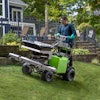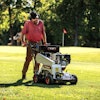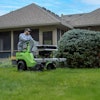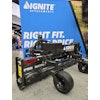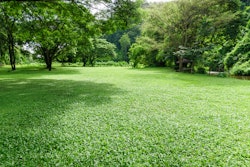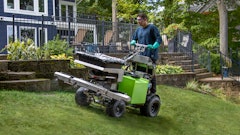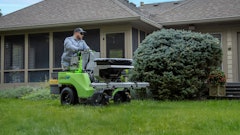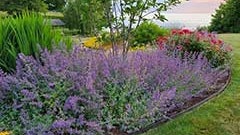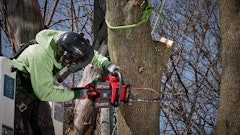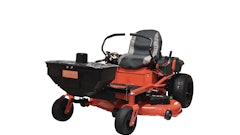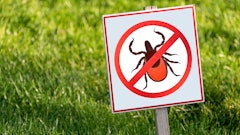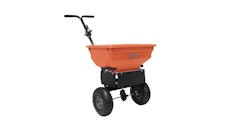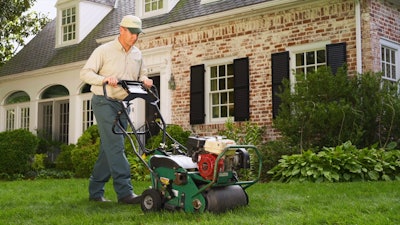
From backyard barbeques to pool days, late summer through early fall is a popular season for homeowners to spend time outside, often using their lawn as the host venue. While homeowners can enjoy this time period outdoors with friends and family, it also provides optimum weather conditions needed to successfully perform aeration and overseeding in many regions throughout the country. However, despite the known benefits among professionals, many homeowners are not choosing to perform this lawn care vitalization effort.
As professionals, we understand the value of aeration and overseeding to restore and sustain growth for a healthy and thick lawn come spring. Aeration extracts cores of soil, thatch and grass from the lawn surface, while overseeding helps to introduce more resilient varieties of grass into the lawn, bettering its overall health and appearance. Without aeration and overseeding, lawns often struggle to regain density and vigor after harsh summer stresses like drought or insect damage.
Common Misconceptions
Aeration and overseeding are not frequently part of a homeowner’s maintenance routine, and they will likely ask you a number of questions about the service and its purpose while you’re in the field. As such, separating fact from fiction and debunking common misconceptions about aeration and overseeding ensure this process becomes an integral, annual part of their lawn maintenance.
#1: Aeration and overseeding aren’t necessary components of lawn care maintenance
Most homeowners are familiar with tasks such as mowing, weeding, watering and fertilizing, and they incorporate these as part of their essential lawn care routine. Unfortunately, many are not as familiar with aeration and overseeding, or don’t understand the benefits and potential impact of these treatments. In fact, according to a recent survey, 75 percent of homeowners do not conduct aeration and seeding at all. This data underscores a common misconception among homeowners that aeration and overseeding is an optional lawn care task, rather than a requirement.
Aeration provides several benefits to the lawn by ensuring roots have access to receive oxygen, water and essential nutrients for maximum health and thickness. When aeration is performed in the fall, it directly addresses summer stress, including soil compaction and thatch buildup, and ensures a strong foundation for the lawn to revive by spring. While dead grass roots and stems can break down and decompose on their own, aeration optimizes the process to prevent excess thatch accumulation, which often leads to potential insect and disease problems.
Overseeding can thicken turf for cool-season grasses, helping to improve the appearance of a lawn by filling in bare spots and addressing thinning areas. Additionally, this task can support weeds, a common nuisance among homeowners, and help crowd out encroaching ones. The survey found that among respondents who aerate and seed their lawn, 62 percent are satisfied with their lawn’s resistance to weed growth, in comparison to the 51 percent who do not conduct the service. Additionally, many homeowners are unaware of the advancements that have been made by the industry to develop improved varieties of grass seed more tolerant of damaging insects, disease and drought and how this helps to improve the lawns overall vigor.
#2: Fall is wrong the season
On the other hand, many homeowners who do include aeration and overseeding in their lawn care regimen conduct the service in the wrong season. Among the survey respondents, only 12 percent know that fall is the best season for this service, with the remaining 78 percent performing it in the wrong season. While this myth highlights a need for greater understanding of the service, it also brings to light another misconception about lawn care.
Lawn care professionals know that a green lush lawn doesn’t grow overnight, yet 86 percent of homeowners aren’t preparing their lawn during the fall season, which is critical to achieve these results. While most lawn care maintenance needs to happen in the spring, there are some tasks that should actually begin in the fall for optimal results the following year, including aeration and overseeding.
To maximize the benefits of aeration and overseeding, it is vital these services be conducted during the optimal timeframe: August through October. The fall season offers ideal soil and weather conditions to conduct aeration and overseeding. The cooler weather allows grass seed to better germinate and establish a strong root system ahead of the winter season. This timing has been proven to result in the development of healthy stands of grass.
#3: Homeowners can do it themselves
Beyond timing, there is a greater technique and expertise required to properly conduct aeration and overseeding. While many homeowners can opt to DIY this service, it is one of the most challenging lawn care tasks, compared to other more common tasks and should be left to professionals. Without the proper training, homeowners may conduct the task improperly which can ultimately cause greater expenses and preventable damage to the landscape including sprinkler heads, lighting, trees, fences and the lawn itself.
Lawn care companies can share insights and best practices with their customers on how to conduct this service. In addition, according to the survey, homeowners who outsourced aeration and seeding to a pro were more satisfied with their lawn than those who didn’t. Specifically, these individuals were satisfied with their lawn’s thickness (78 percent), color (77 percent), overall health (74 percent) and appearance (73 percent), as compared to those who DIY'd this task.
As professionals in the lawn care industry, our goal is to partner with homeowners to provide an understanding about their lawn and help them achieve their dream outdoor space. Emphasizing the importance of open dialogue with customers to help combat the misconceptions that arise from inadequate education will increase awareness about the importance of critical lawn services such as aeration and seeding.

